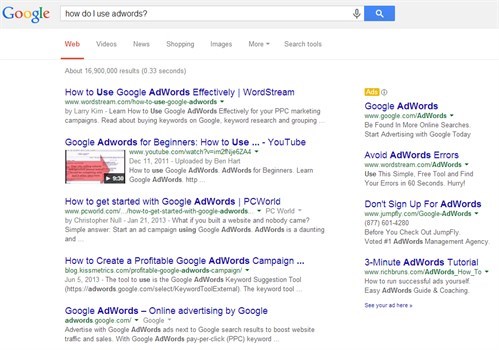Changes in Google’s AdWords algorithm, and what they mean for marketers
22 July 2014
Search engine marketing is big business and highly competitive. With the right investment, a savvy company can bring in big profits by introducing potential customers to their brand via pay per click (PPC) advertising. It’s not without risks. With poor management, a marketer can make a sizeable investment in PPC and have nothing to show for it. PPC is quick, nimble, and simple to measure. There are a few things you should understand to make PPC work for you and your business:
Paid placement and ranking
Because PPC ads appear in context with organic traffic, it’s important to Google and Bing that the paid placements deliver quality results, just like the organic traffic.
Because you want to be at the top of the page, it’s important to understand that the order of the ads is established by an important algorithm system called Ad Rank. Ad Rank is calculated using the maximum Cost per Click bid and a Quality Score – a measure of how relevant an ad, keyword and landing page are to a person’s search term.

Ad Exchanges and Algorithm changes
Any PPC advertiser should get a quick education on ad extensions, which allow an ad to present additional information to a single click-through link, such as a business number, retail location a more relevant landing page.

An AdWords algorithm change that came last year, the most significant in some time, effected how ad extensions influence the position of an ad on a page.
If two ads are competing with the same bid and quality score, the one with a better expected positive impact from the ad extensions will appear in a higher position. Google measures the expected impact through relevance, click-through rates and the prominence of the extensions or formats on the search results page. Further, only the top placed ads are able to display their ad extensions.
Therefore, when you advertising with Google AdWords, you should take special care with your ad extensions as they are crucial in determining both ad position and the ways a searcher can interact with your business on the page.
Why did Google change its paid search algorithms?
Google's whole search ethos is centered on providing helpful, relevant results, for both organic search and paid ads. It makes regular changes to its algorithms (see Panda and Hummingbird), so it's no surprise that Google favors advertisers that provide ads which are more useful to searchers and emphasises the Quality Score ad extensions.
Some companies push harder to reach top spots by raising bids or boosting Quality Scores - it might be easier and more profitable to simply invest more money than play guesswork with an algorithm.
Ad extensions on Bing
If you're using Bing Ads, you should also get the ad extensions right. Bing Ads allows you to adapt three types of ad extension.
1. Location Extensions
This allows an advertiser to show the address of a business location, as well as include a local phone number. If you have multiple business locations set up for a campaign, Bing Ads can display the address and phone number for the location closest to the customer.
2. Call Extensions
This allows an advertiser to provide a phone number not associated with a particular location, but is instead appropriate for all locations where ads display. It’s possible to make an ad call-only, which may be useful if you don't have an appropriate landing page for your campaign.
3. Sitelink Extensions
These are additional links on an ad which can take customers to specific landing pages on a website, which can increase both click-through rates and conversions.
Anyone who is advertising on Amazon and eBay may be interested in changes to Froogle, Google’s shopping search engine. Wall St. Cheat Sheet breaks it down here.

